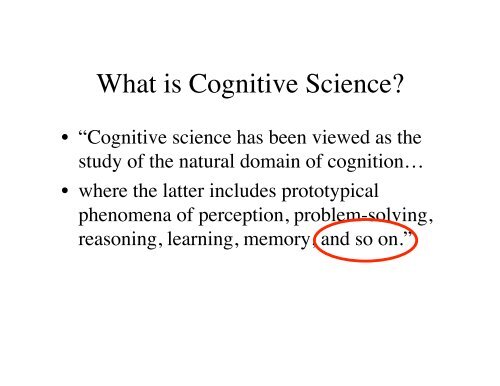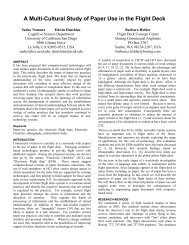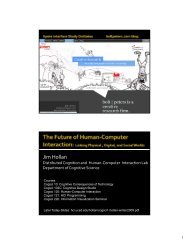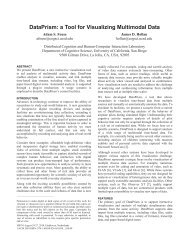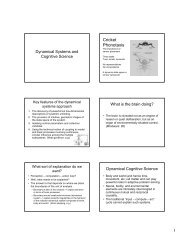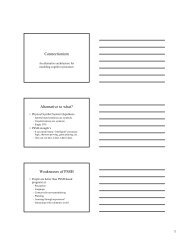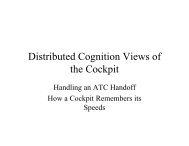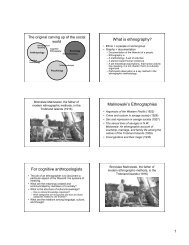What is Cognitive Science? - UCSD Distributed Cognition and ...
What is Cognitive Science? - UCSD Distributed Cognition and ...
What is Cognitive Science? - UCSD Distributed Cognition and ...
You also want an ePaper? Increase the reach of your titles
YUMPU automatically turns print PDFs into web optimized ePapers that Google loves.
<strong>What</strong> <strong>is</strong> <strong>Cognitive</strong> <strong>Science</strong>?• “<strong>Cognitive</strong> science has been viewed as thestudy of the natural domain of cognition…• where the latter includes prototypicalphenomena of perception, problem-solving,reasoning, learning, memory, <strong>and</strong> so on.”
How to make a field in science1. Round up some phenomena that seem related.2. Find some principles that unify thephenomena or that explain patterns <strong>and</strong>regularities3. Use those principles to put boundaries on thedomain of inquiry. Specify what <strong>is</strong> in <strong>and</strong>what <strong>is</strong> out.4. Figure out how the stuff in the domain works
Reason respecting behavior• Info processing psychology – knowledge,goals, plans, means• Language (formal lingu<strong>is</strong>tics)• Theorem proving• Chess <strong>and</strong> other games
The attribution problem in<strong>Cognitive</strong> <strong>Science</strong>• We can’t see the processes we care the mostabout, so we must infer them fromobservable behavior. • But how can we infer the inv<strong>is</strong>ible?• Well, …what <strong>is</strong> v<strong>is</strong>ible? • Reason-respecting behavior.• How can we account for that?
Formal Systems• We know of another system that produces reasonrespectingsequences. • It’s LOGIC• FORMal, get it?• Strings of symbols• Rules for manipulating strings of symbols• “If you take care of the syntax, the semantics willtake care of itself.” (Haugel<strong>and</strong>, 1981)
The classical view of computing <strong>and</strong>cognition (PSSH)• Symbols <strong>and</strong> expressions• Meanings are composed of meaning elements• Formal operations transform expressions• Three d<strong>is</strong>tinct levels – knowledge/computational • (what does it do?)– symbol/representational • (how <strong>is</strong> the doing organized?)– biology/implementation • (what stuff does it?)
Formal Systems have a h<strong>is</strong>tory
Early Accounting SystemsSix ovoid tokens representing an account ofsix units of oil
Early Accounting SystemsPlain tokens. Mesopotamia, 4000 B.C.
Early Accounting SystemsAn envelope <strong>and</strong> its contents representing 7units of oil
Early Accounting SystemsAn envelope, its contents of tokens, <strong>and</strong>corresponding markings. 3300 B.C.
Early Accounting SystemsComplex tokens. Sheep, oil, metal, garment.3300 B.C.
Early Accounting SystemsImpressed tablet showing an accountof grain. 3100 B.C.
Early Accounting SystemsPictographic tablet showing 33 units ofoil. 3100 B.C.
Properties of Spoken <strong>and</strong> WrittenLanguage• Spoken– Ephemeral– Dynamic– Auditory (sound)– Structure in time• Written– Semi-permanent– Static– V<strong>is</strong>ual (sight)– Structure in space
decontextualizationdecontextualizationnotwithweave orsurroundsrelation toto make or takethe act
Binary addition as a formal systemT ::= o|x|To|Tx (where ::= means “<strong>is</strong> defined to be” <strong>and</strong> “|” means“or”)The semantic function can then be defined recursively as follows,using the definition of the strings provided above:(1) SF(o) = 0 (the semantic interpretation of “o” <strong>is</strong> the number zero)(2) SF(x) = 1 (the semantic interpretation of “x” <strong>is</strong> the number one)(3) SF(To)= 2*SF(T) (the semantic interpretation of a string Tfollowed by “o” <strong>is</strong> two times the semantic interpretation of T alone)(4) SF(Tx)= 2*SF(T) + 1(the semantic interpretation of a string T followed by “x” <strong>is</strong> twice thesemantic interpretation of T alone plus one).
The Secret of Our SuccessThe world of things<strong>and</strong> eventsEncodingDecodingRepresentations ofthe world of things<strong>and</strong> eventsFormaloperationsNew representationsof the world
The Secret of Our SuccessThe world of things<strong>and</strong> eventsFalling objectEncodingt = 0x = 0a = g = 9.8m/sec 2v = gtx = 1/2gt 2Falls 490m in10 secondsDecodingt = 10 sec.x = 1/2 g 100= 50g meters
Getting symbols to behave in away that fits the world• Why does th<strong>is</strong> turn out to be possible? • Why <strong>is</strong> the world a place that can bemodeled by mathematics? • No one knows, but it DOES work!
Consider the abacusHere patterns of beads represent numbers. People learnrules for transforming these patterns of beads in such away that the semantic interpretation of before-<strong>and</strong> afterpairs corresponds to a useful mathematical function. Butthere <strong>is</strong> nothing instrinsically mathematical about therules themselves: they are just rules for moving beadsaround. <strong>What</strong> makes the rules useful for doingmathematics <strong>is</strong> that we are assured of a certaincontinuing correspondence between the formal orsyntactic patterns of beads <strong>and</strong> mathematical objects(such as numbers).
The Turing Machine• An imaginary (theoretical) device. • It works by manipulating meaninglesssymbols. • It can compute the answer to anysufficiently well-specified problem. • Digital computers are not imaginary, <strong>and</strong>they can be equivalent to a Turing machine.
The three big pieces of early1. Formal Systems<strong>Cognitive</strong> <strong>Science</strong>2. Meaningful computation by mindlesslyfollowing rules3. Mechanized symbol manipulation
Mindware as reason-respectingSoftware• In a formal system, state plus operatorimplies a new state,• States of mind could lead to other states ofmind in ways that follow rules.• It <strong>is</strong> the program that matters. • The machine it runs on <strong>is</strong> “a mereimplementational detail.”
Physical Symbol System• Symbolic CodesHypothes<strong>is</strong>• <strong>Cognition</strong> happens at the level ofdeliberative thought – symbol orrepresentational level• Intelligence, wherever it <strong>is</strong> found, will befound to be a physical symbol system.
Reverse Engineering• Pick something that people do that <strong>is</strong> smart. • Figure out how to do that same thing on acomputer. • Then look at the program in the computer.It should tell you something about thenature of the task <strong>and</strong> the things the personmust do in order to perform the task.
And it works!• Th<strong>is</strong> <strong>is</strong> exciting!• Just document the I/O relations,• build a program that can do the job (thesufficiency criterion), • <strong>and</strong> then look inside to see how it does it. • Wow!
Can we get symbols to work in away that fits the brain?• An empirical hypothes<strong>is</strong>: Physical symbolsystem hypothes<strong>is</strong>.
Could the brain be a meat computer?• The program (the rules) run by the brainmust be a formal system• Brain states must correspond to symbols orpropositions in a formal language. • Functional equivalence of your brain statesto mine – Not identity. • Brain states must cause other brain states injust the right “reason-respecting” way.
The meat wouldn’t matter• If we knew the program, we could run it onany suitable computer. • Then we would have an artificial humanmind! • And we already know how to do th<strong>is</strong>.
Ok, But….• The time course of real-world action • There are many levels of software. Arethere also levels of mindware?• Are games good representatives ofcognitive tasks?• Is the Turing test a good representative?
OK, But…(continued)• Engineering A/I vs Research A/I• Consciousness (the C word) <strong>and</strong> qualia• Language <strong>and</strong> Searle’s Chinese Room
Searle’s Chinese Room• A person (you?) in a room with a slot in the door.– Book of rules– Box of symbols• Chinese people outside push strings of symbolsthrough the slot• You use the rules to make new strings <strong>and</strong> pushthem out the slot.• Do you speak chinese? Does the room?
Why not formal symbols?• <strong>What</strong> symbolic computers do well <strong>and</strong> whatpeople do well. • Nature doesn’t work like that.• The metaphor <strong>is</strong> vague.• Every device, considered at different levels,could be a model of many different things.
Questions remain• If the PSSH does not describe what thebrain does, what explanation do you offerinstead? <strong>What</strong>’s the alternative?• If the brain doesn’t do PSSH, – <strong>What</strong> does the brain do? – And what does PSSH? • (because ban<strong>is</strong>hing PSSH from the brain doesn’tmake it go away.)
Is the Meat Magic?• The answer depends on whether or not wethink consciousness <strong>is</strong> simply a matter ofinformation processing.
Two aspects of mindfulness?• Reason respecting flow of thoughts• Everything else– Qualia– Affect/emotion– Embodiment Are these really different aspects?
Examining assumptions• <strong>What</strong> was modeled? “Every such operationcons<strong>is</strong>ts of some change of the physical systemcons<strong>is</strong>ting of the computer <strong>and</strong> h<strong>is</strong> tape.”Turing, 1937• Are the levels really separable?• Are embodied meanings compositional? • Explore: <strong>is</strong> an abacus a computer? No.• Is the navigation team a computer? Yes. Noticehow well the account works for a socioculturalsystem.
Still doing science – boundingthe field• Once upon a time, PSSH was the only gamein town (if we all do that how will analternative ever come along?)• Co-constitution of theory <strong>and</strong> phenomenafor which the theory will be responsible. Eg.Turing test
Why the <strong>UCSD</strong> department of cognitivescience does not study cognitive science.It would be both surpr<strong>is</strong>ing <strong>and</strong> troublesome if too many of whatwe pretheoretically took to be clear cases of cognition ended upbeing omitted in the process. But it would also not be entirelysurpr<strong>is</strong>ing if some of our favorite c<strong>and</strong>idate “cognitive”phenomena got left out. For example, it could turn out thatconsciousness <strong>is</strong> not something that can be given a computationalaccount. Similarly, certain kinds of stat<strong>is</strong>tical learning, aspects ofontogenetic development, the effect of moods <strong>and</strong> emotions, <strong>and</strong>many other important <strong>and</strong> interesting phenomena could simplyend up not being amenable to a computational account. P40


